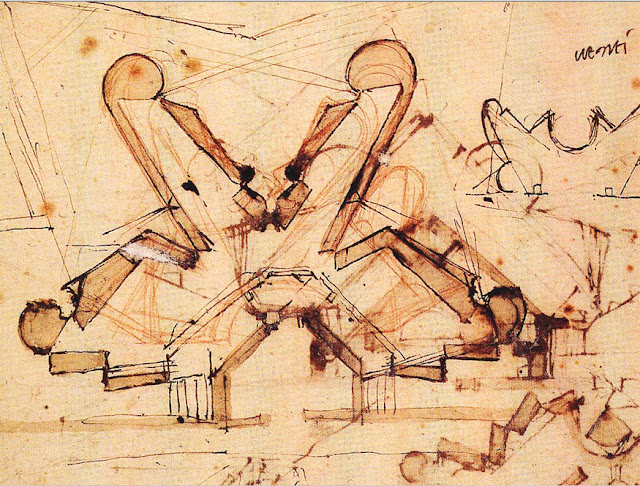I first came across these images of Michelangelo’s designs for fortified defenses around Florence on the blog of Lebbeus Woods. They are hugely compelling visual documents, which only but hint at Michelangelo’s enormous repertoire of invention.
Michelangelo was commissioned by the Florentine Republic to design these bastions in the early part of the 16th Century. At this time Florence was under the threat of attack from the Papal armies wishing to restore the Medici family to autocratic power.* When the attack arrived, the city’s defensive wall had been strengthened by Michelangelo’s fortifications. As a result Florence was able to defend herself for close to a year against a supreme army. Florence succumbed to the military might through an act of political treachery in 1530. *
The geometries of these drawings derive from their very practical purpose, allowing structural defense from the incoming missiles of the attackers and allowing retaliation from the defenders.
On their own they radiate a complex beauty and power. As an architect looking upon these drawings, the forms look almost contemporary not something expected from the renaissance epoch. The top image here is particularly powerful, as begins to hint at the mechanics of Michelangelo’s genius. The plan appears to be drawn in ink with the masterly control of superfluous brush strokes. Interestingly it lies on top of a set stunning and sensitive figure studies. Other sketches in this set also create a superimposition of the architectural solution atop of the figurative study. Here is an interesting point to depart into a conversation on the interwoven links between the depth of Michelangelo’s anatomical understanding and his engineering faculties.
For me these sketches from the great renaissance masters illustrate the importance of fluidity within architectural thought and discipline. It could be argued, that the diet of intensive observational and anatomical drawing that the renaissance period cultivated develops a powerful non verbal understanding of mechanical and structural principles. Lebbeus Woods, argues that it is Michelangelo’s extreme precision and dexterity with free hand line (no doubt a result from his latent genius and hard graft refining this skill through observational drawing) that allows him to be so courageous and inventive with the forms explored in these sketches.
These sketches, largely unseen amidst the multitude of masterpieces from Michelangelo, are just as inspiring. They remind us of important faculties we possess as humans, and the latent potential of imagination fused with perseverance and dedication.
*http://lebbeuswoods.wordpress.com/2012/05/22/michelangelos-war/














No comments:
Post a Comment